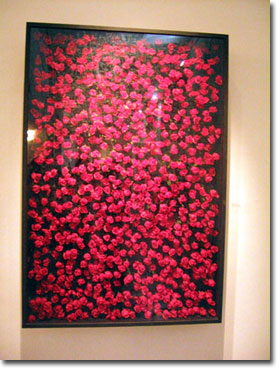Centro Cultural Recoleta ,
Dec 16, 2004 - Feb 27, 2005
Buenos Aires, Argentina
León Ferrari: Retrospective. Works 1954-2004
by Viviana Usubiaga
Poetic Justice
According to Ferrari The West ensures that its history is developed between two legal acts. It begins with the original sin of Eve, whose passion for knowledge led to a divine judgment that has afflicted humanity, and will end with a Final Judgment after the Apocalypses. Man has done nothing more than to erect societies that maintain themselves through inequality. The exercise of disassociative practices in and between subjects puts into play a system of differentiation that is a condition and a result of the relationships of power (6). The arbitrary nature of Western rationality apparent in the discourses of justice, religion, the State, science, and art which expands intolerance and chastises the individual (on Earth and in Heaven) is a target of the artist's criticism.
In order to encourage the exercise of thought, Ferrari works consecutively off his own ideas and those of his dissenters, thus highlighting an impartiality of opinions. In 1991 he exhibited a piece entitled La Justicia in which a hen defecated indiscriminately on plates of a weighing machine. Shorn of any euphemism, the directness of the rhetoric spurred an immediate reaction from the public. Expressions of support or repudiation are always reused as they become the subject matter of later works or form part of a scenario which extends their effects. The letters received at that time in defense of the hen or demands for better conditions for the animal (relating to conditions suffered by this and other animals) served to accompany an exhibition of the work one year later, but with the hen stuffed and under the title Autocensura.
There are works in this exhibition which could offend the religious or moral sensitivity of the visitor.
The exhibition has offered one of the most exhaustive examinations of Ferrari's art over the past fifty years. The strict selection of works several items shown in Argentina for the first time and its design according to museum standards, so cautious and novel for Buenos Aires, have allowed for a generous understanding of his work.
The exhibition proposes a tour of thematic nuclei while, at the same time, unraveling orthodox chronologies which respects the artist's own digressions and returns. The first rooms bring together his wire sculptures and drawings from 1961, together with his notebooks. The presence of letters exchanged with the Spanish poet Rafael Alberti seem to safeguard the deeply poetical nature of this series of works, which touch on the sensuality of lines in space. Located at the center of the exhibition, La Civilización Occidental y Cristiana extends its power of criticism to other works which question religion as a source of violence. Different groupings bring together works which experiment with transparencies, containers, the body, sensuality and the organic (series of bottles, of braille, of the Maniques, of excrement). One is able to read a catalogue of the varied materials with which the artist works. The final nuclei brings together the works dealing with power and violence (Letraset series, illustrations for the pages of Nunca Mas, the Infiernos, the Cajas con flores).
Prior to the inauguration of the exhibition on November 30, 2004, the management of the Centro Cultural Recoleta received various messages from individuals and Catholic groups asking for the exhibit not to be opened to the public. This petition charged that several pieces were blasphemous. Complaints were addressed specifically to works that re-fashioned Christian iconology without taking their artistic nature into consideration, looking instead at the capacity of these objects to offend the faithful. Although, it is arguably true that if comparatively studied as a whole, other works are infinitely more fascinating from an aesthetic viewpoint. Another issue was the complaint that the exhibition took place at a public cultural center, financed by the public treasury for the city of Buenos Aires. This gave rise to demonstrations. The exhibition was inaugurated as planned, but regrettably some works were violently attacked a few moments after the opening, unleashing a series of protests and debates by many intellectuals on freedom of expression, security, and condemning the relationship between the Church and the Argentine state. As a result, several lawsuits were filed, the exhibition closed for ten days, there were appeals, public acts that mobilized the artistic community, and a never before seen interest from the media on the story of the reopening due to a court ruling, which it considered an act of judicial censorship. Nevertheless there were repeated bomb threats received both by the cultural center,and the artist himself.
|













